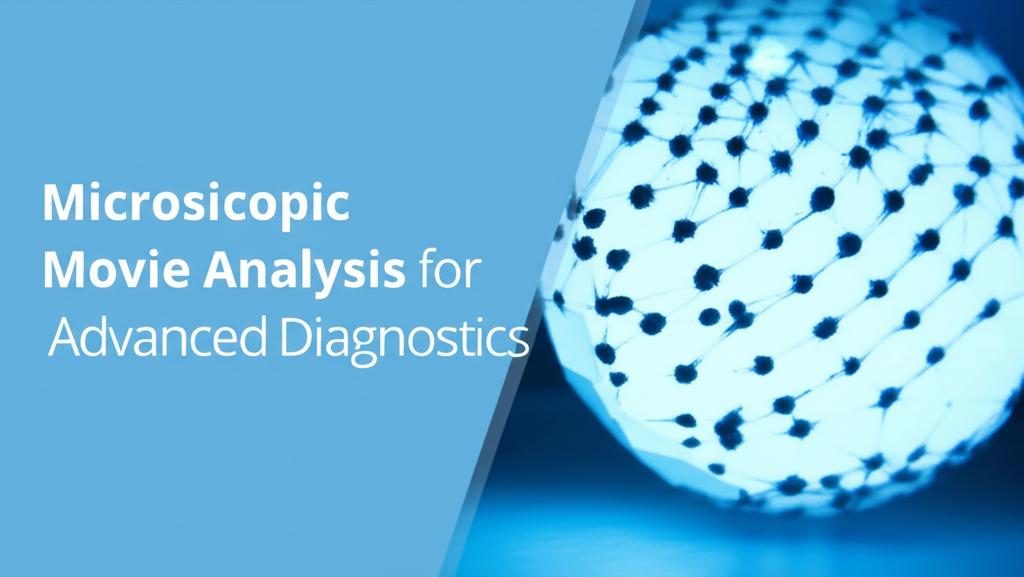The analysis of microscopic movies is rapidly transforming advanced diagnostics, offering unprecedented insights into cellular and subcellular processes in real-time. This evolving field is driven by significant advancements in imaging technologies, computational power, and the integration of artificial intelligence (AI), leading to more accurate, faster, and predictive diagnostic tools.
Key Technological Strides:Recent breakthroughs are pushing the boundaries of what can be observed and analyzed at the microscopic level. Innovations in live-cell imaging, such as the development of new fluorescent probes and viability dyes, are expanding the range of possible applications. Techniques like super-resolution microscopy, including Leica Microsystems' TauSTED Xtend for nanoscopic multicolor live-cell imaging, are becoming more accessible. Furthermore, attosecond electron microscopy is now capable of creating movies of light-matter interactions at attosecond and nanometer resolutions, allowing researchers to observe fundamental atomic and electronic processes.
The integration of AI and big data analytics is a game-changer for microscopic movie analysis. AI algorithms, particularly deep learning networks and computer vision techniques, can analyze vast amounts of image data, identify patterns, track cellular structures, and even predict abnormalities like tumors with increased efficiency and accuracy. AI-powered image analysis software, such as Revvity's Phenologic.AI and Danaher's ImageXpress HCS.ai High-Content Screening System, are streamlining complex cell model imaging and data analysis. This not only speeds up the diagnostic process but also reduces the potential for human error and allows pathologists to focus on more complex aspects of research and patient care.
Oblique illumination technology is another significant advancement, enhancing contrast and visual resolution to reveal subtle changes in cellular structures, which is particularly beneficial for observing cellular dynamics during development, disease progression, and therapeutic interventions. This technique can transform standard 2D microscopes into powerful 3D visualization tools, offering deep insights across various research domains including neuroscience, vascular studies, and pathology.
Applications in Advanced Diagnostics:Microscopic movie analysis is finding diverse applications across the medical field. In oncology, it aids in the early detection and characterization of cancer cells and their surrounding tissues at an individual cell level. For instance, the integration of holography microscopic medical imaging with deep learning techniques shows promise in capturing detailed structural information of biological structures, paving the way for more accurate cancer diagnostics. AI-enabled microscopy is also proving invaluable in diagnosing infectious diseases like malaria, with systems like miLab MAL demonstrating improved sensitivity in detecting Plasmodium species, especially in low-parasitemia settings, compared to traditional microscopy.
The technology is crucial in drug discovery and development, allowing researchers to perform kinetic studies, analyze the mode of action of compounds, and observe the motion of cellular components in real-time. High-content imaging combined with AI is accelerating progress in this area. Moreover, live-cell imaging is integral to cell and gene therapy, providing real-time quality monitoring and clinical validation.
Portable and smartphone-based microscopy systems, often integrated with cloud technologies and AI for automated image processing, are emerging as cost-effective and accessible solutions for diagnostics, particularly in resource-limited settings and for educational purposes. These systems can provide real-time analysis and immediate results, which is critical for timely treatment decisions.
Market Growth and Future Outlook:The live-cell imaging market is experiencing robust growth, projected to reach billions of dollars by 2030. This expansion is fueled by continuous technological advancements, the increasing demand for personalized medicine, the rising prevalence of chronic diseases requiring advanced diagnostics, and growing investments in healthcare infrastructure and research. North America and Europe currently dominate the market, while the Asia-Pacific region is expected to witness the fastest growth.
Future trends point towards even more sophisticated and user-friendly systems, driven by increased collaboration between technology providers and research institutions. The development of cloud-based image analysis platforms will further enhance data sharing and collaborative research. Challenges remain, such as the high initial investment costs for advanced systems and the need for large, well-annotated datasets to train AI models effectively. However, ongoing innovations, including self-learning annotation tools and advancements in areas like photoacoustic microscopy and nuclear spin microscopy, promise to overcome these hurdles and continue to revolutionize medical diagnostics. The ultimate goal is to reshape healthcare problem-solving, improve diagnostic accuracy and efficiency, and ultimately enhance patient outcomes.

